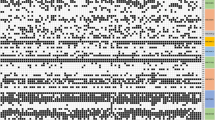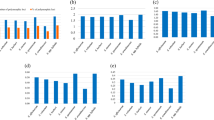Abstract
Capillary electrophoresis-based molecular genotyping was conducted on 35 sugarcane cultivars (Saccharum spp. hybrids) and 5 clones of related wild species with 20 polymorphic SSR DNA markers. A total of 251 alleles were identified with 248 alleles displaying varying degrees of polymorphism and the remaining three alleles being monomorphic. The total number of alleles by any SSR marker varied from as few as 7 to as many as 18, with an average of 12.5 alleles per marker. Diversity index (DI = 1 − \( \sum\limits_{i = 1}^S {Pi^2 } \)) for these SSR markers ranged from 0.71 to 0.91, with a mean of 0.83. A composite parameter NDI, representing a product of the number of alleles (N) and DI, is an indicator on the general usefulness of a DNA marker. Ten SSR markers, namely, mSSCIR43, mSSCIR66, SMC119CG, SMC24DUQ, SMC278CS, SMC31CUQ, SMC336BS, SMC597CS, SMC703BS, and SMC851MS, have NDI values of greater than 12 in comparison to less than 10 from the rest markers, indicating that these 10 SSR markers provide much information for genotyping the 40 clones. A finding to minimize stutters and minus-Adenine peaks gave a guideline for the selection of best SSR markers for other SSR research. The 35 cultivars were clustered into five groups based on pairwise similarity coefficient values and their relationships to the wild species were demonstrated. Inclusion of CP67-412, CP72-1210, N21, N27, and S. officinarum clone Badila into the cultivar groups is due to the fact that these clones have been extensively used as parental material in sugarcane breeding programs. The results are in general agreement with the evolutionary course of the sugarcane cultivars that the order of contributing species in modern sugarcane cultivars is S. officinarum, S. spontaneum, S. robustum Brandes et. Jesw.ex., S. sinense Roxb., and S. barberi Jesweit. The accordance of molecular results with recorded evolution of sugarcane verified the fidelity and usefulness of these 20 SSR markers in progeny selection and allele transmission study in this aneu-polyploidy crop.
Similar content being viewed by others
References
Arcenaux G (1967). Cultivated sugarcane of the world and their botanical derivation. Proc Int Soc Sugarcane Technol 12: 844–854.
Awadalla P, Ritland K (1997). Microsatellite variation and evolution in the Mimulus guttatus species complex with contracting mating systems. Mol Biol Evol 14: 1023–1034.
Brown J.S., Schnell RJ, Power EJ, Douglas SL, Kuhn DN (2007). Analysis of clonal germplasm from five Saccharum species: S. barberi, S. robustum, S. officinarum, S. sinense and S. spontaneum. A study of inter- and intra species relationships using microsatellite markers. Genet Resour Crop Evol. 54:627–648.
Breaux RD, Legendre BL (1983). The USDA Commercial breeding program in Louisiana. Proc. Inter-Amer. Sugar Cane Sem.:Varieties and Breeding III: 99–105.
Burner DM, Legendre BL (1993). Sugarcane genome amplification for the subtropics: a twenty year effort. Sugar Cane 3: 5–10.
Chen C, Yu Q, Hou S, Li YJ, Eustice M, Skelton RL, Veatch O, Herdes RE, Diebold L, Saw J, Feng Y, Qian W, Bynum L, Wang L, Moore PH, Paull RE, Alam M, Ming R (2007) Construction of a Sequence-Tagged High-Density Genetic Map of Papaya for Comparative Structural and Evolutionary Genomics in Brassicales. Genetics 177: 2481–2491
Chen PH, Pan YB, Chen RK (2008). High-throughput Procedure for Single Pollen Grain Collection and Polymerase Chain Reaction in Plants. J Integr Plant Biol 50(3): 375–383.
Cordeiro GM, Casu R, McIntyre CL, Manners JM, Henry RJ (2001). Microsatellite markers from sugarcane (Saccharum sp.) ESTs transferable to Erianthus and sorghum. Plant Sci 160: 1115–1123.
Cordeiro GM, Pan YB, Henry RJ (2003). Sugarcane microsatellites for the assessment of genetic diversity in sugarcane germplasm. Plant Sci 165: 181–189.
Cordeiro GM, Taylor GO, Henry RJ (2000). Characterisation of microsatellite markers from sugarcane (Saccharum sp.), a highly polyploid species. Plant Sci 155: 161–168.
D’Hont A, Grivet L, Feldmann P, Rao S, Berding N, Glaszmann JC (1996). Characterisation of the double genome structure of modern sugarcane cultivars (Saccharum sp.) by molecular cytogenetics. Molecular Genetics and Genomics 250: 405–413.
D’Hont A, Rao PS, Feldmann P, Grivet L, Islam-Faridi N, Taylor P, Glaszmann JC (1995). Identification and characterisation of sugarcane intergeneric hybrids, Saccharum officinarum X Erianthus arundinaceus, with molecular markers and DNA in situ hybridisation. Theor Appl Genet 91: 320–326.
Divinagracia NS (1980). Emasculation of sugarcane flowers: steam method. Proc Intl Sugar Cane Technol 17: 1287–1295.
Heinz DJ, Tew TL (1987). Hybridization procedures. In: Sugarcane Improvement through Breeding. D.J. Heinz (eds.), Elsevier, Amsterdam, pp 313–342.
Krishnamurthi M (1977). The sugarcane pollen. Proc Intl Sugar Cane Technol 16: 157–164.
Legendre BL, Breaux RD (1983). The USDA basic sugarcane breeding program in Louisiana. Proc Inter-Amer Sugar Cane Sem: Varieties and Breeding III: 96–98.
Maccheroni W, Jordao H, De Gaspari R, De Moura GL, Matsuoka S (2009) Development of a dependable microsatellite-based fingerprinting system for sugarcane. Sugar Cane Intl. 27(2):47–52.
McIntyre CL and Jackson PA (2001). Low level of selfing found in a sample of crosses in Australian sugarcane breeding programs. Euphytica 117:245–249.
Nei, M (1973). Analysis of Gene Diversity in Subdivided Populations. Proc Nat Acad Sci USA 70: 3321–3323.
Oliveira KM, Pinto LR, Marconi TG, Mollinari M, Ulian EC, Chabregas SM, Falco MC, Burnquist W, Garcia AAF, Souza AP (2009) Characterization of new polymorphic functional markers for sugarcane. Genome 52:191–209.
Pan YB (2001). Potential impact of biotechnology on sugarcane breeding. Sugar Cane Intl 14–17.
Pan YB (2006). Highly polymorphic microsatellite DNA markers for sugarcane germplasm evaluation and variety identity testing. Sugar Tech 8(4): 246–256.
Pan YB, Burner DM, Legendre BL (2000). An assessment of the phylogenetic relationship among sugarcane and related taxa based on the nucleotide sequence of 5S rRNA intergenic spacers. Genetica 108: 285–295.
Pan YB, Burner DM, Wei Q (2001). Developing species-specific DNA markers to assist in sugarcane breeding. Proc Intl Sugar Cane Technol 24(II): 337–342.
Pan YB, Miller JD, Schnell RJ, Richard Jr. EP, Wei Q (2003). Application of microsatellite and RAPD fingerprints in the Florida sugarcane variety program. Sugar Cane Intl March/April: 19–28.
Pan YB, Scheffler BS, Richard JEP (2007). High-throughput genotyping of commercial sugarcane clones with microsatellite (SSR) DNA markers. Sugar Tech. 9:176–181.
Pan YB, Tew TL, Schnell RJ, Viator RP, Richard EP, Grisham MP White WH (2006). Microsatellite DNA marker-assisted selection of Saccharum spontaneum cytoplasm-derived germplasm. Sugar Tech 8(1): 23–29.
Powell W, Machray GC, Provan J (1996). Polymorphism revealed by simple sequence repeats. Trends Plant Sci 1: 215–222.
Roach BT (1989). Origin and improvement of the genetic base of sugarcane. Proc Aust Soc Sugar Cane Technol 11: 34–47.
Rohlf FJ (1998) NTSYS-pc: Numerical Taxonomy and Multivariate Analysis System (Version 2.0). Exeter Software, Setauket, New York.
Selvi A, Nair NV, Noyer JL, Singh NK, Balasundaram N, Bansal KC, Koundal KR, Mohapatra T (2006) AFLP analysis of the phenetic organization and genetic diversity in the sugarcane complex, Saccharum and Erianthus. Genet Res Crop Evol 53: 831–842.
Simpson HE (1949). Measurement of diversity. Nature 163: 688.
Singh RK, Singh P, Misra P, Singh SP, Singh SB (2005) STMS Marker for Tagging High Sugar Genes in Sugarcane. Sugar Tech 7(2&3): 74–76.
Tai PYP (1989). Progress and problems of intergeneric hybridization in sugarcane breeding. Proc Inter-Amer Sugar Cane Sem I: 391–395.
Tew TL (2003). World sugarcane variety census — Year 2000. Sugar Cane Intl March/April: 12–18.
Tew TL, Pan YB (2005). Molecular Assessment of the Fidelity of Sugarcane Crosses with High-Throughput Microsatellite Genotyping. Journal of the American Society of Sugar Cane Technologists 25: 119.
Tew TL, Pan YB (2006). Microsatellite-based paternity analysis of a seven-parent sugarcane polycross [abstract]. In: 8th International Society of Sugar Cane Technologists Breeding and Germplasm Workshop Abstract Book, May 1–5, 2006, Guayaquil-Ecuador. p. 5.
Author information
Authors and Affiliations
Corresponding author
Rights and permissions
About this article
Cite this article
Chen, P.H., Pan, Y.B., Chen, R.K. et al. SSR marker-based analysis of genetic relatedness among sugarcane cultivars (Saccharum spp. hybrids) from breeding programs in China and other countries. Sugar Tech 11, 347–354 (2009). https://doi.org/10.1007/s12355-009-0060-2
Received:
Revised:
Accepted:
Published:
Issue Date:
DOI: https://doi.org/10.1007/s12355-009-0060-2




